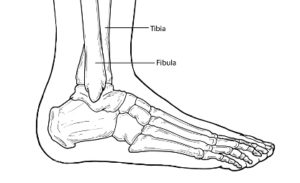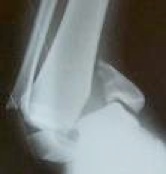
What Is an Ankle Fracture?
A fracture is a partial or complete break in a bone. Fractures in the ankle can range from the less serious avulsion injuries (small pieces of bone that have been pulled off) to severe shattering-type breaks of the tibia, fibula or both. Ankle fractures are common injuries most often caused by the ankle rolling inward or outward. Many people mistake an ankle fracture for an ankle sprain, but they are quite different and therefore require an accurate and early diagnosis. They sometimes occur simultaneously.
For the most part, your concern is the same as the doctor’s: Is there a broken bone? Frequently it is difficult to diagnose a fracture (broken bone) over a sprain, a dislocation, or tendon injury without x-rays of the ankle.
- The ankle joint is made up of 3 bones coming together.
- The tibia, which is the main bone of the lower leg,makes up the medial, or inside, anklebone.
- The fibula is a smaller bone that parallels the tibia in the lower leg and makes up the lateral, or outside, anklebone.
- The far ends of both the tibia and fibula are known as the malleoli. Together they form an arch that sits on top of the talus, one of the bones in the foot.
- These 3 bones (tibia, fibula, and talus) make up the bony elements of the ankle joint.
- The ankle joint is stabilized by 3 groups of ligaments, which are fibers that hold these bones in place.

Ankle Fracture Causes
When you stress an ankle joint beyond the strength of its elements, you injury the joint.
- If only the ligaments give way and tear, you have sprained the ankle.
- If a bone gives way and breaks, you have an ankle fracture.
- Fractures can occur with simultaneous tears of the ligaments. You can do this in several ways:
- Rolling the ankle in or out
- Twisting the ankle side to side
- Extreme flexing or extending of the joint
- Severe force applied to the joint by coming straight down on it as in jumping from a high level
Ankle Fracture Symptoms
igns and symptoms of ankle injuries and fractures tend to be obvious.
- Pain is the most common complaint.
- Often the pain will not come from the exact area of the fracture.
- You may experience associated fractures of your foot (especially on the side of the small toe) or knee that also cause pain.
- It is usually pain in the ankle that stops you from walking.
- Swelling frequently occurs around the ankle too.
- Swelling suggests either soft tissue damage with possible blood around the joint or fluid within the joint itself, most likely blood.
- When blood is in the joint, it is called hemarthrosis
- You may see bruising (“black and blue”) about the joint, although not immediately. This bruising can track down toward the sole of your foot or toward the toes.
- In severe fractures you may see obvious deformities of bones around the ankle.
- Your skin may be stretched over an underlying broken bone.
- You may see actual exposed bone.
If you injure nerves or blood vessels that supply your foot, you may experience even more pain along with pale skin in the foot, numbness, or inability to move your foot or toes.
Exams and Tests
When a doctor evaluates your ankle, the main task is to determine if you have fractured a bone or if the joint has been damaged sufficiently to have become unstable. Joint instability often suggests multiple fractures, a fracture with a ligament injury, or sometimes ligament injury alone.
The doctor will seek a history of the injury and will ask the following. These questions are important because different mechanisms of injury are associated with different fracture patterns.
- Where does it hurt now?
- How long ago did your injury happen?
- Does your knee, shin, or foot hurt also?
- How did the injury happen?
- Did your ankle turn in or out?
- Did you hear a crack or a pop?
- Were you able to walk immediately after the injury?
- Can you walk now?
- Do you have any new numbness or tingling in your leg, ankle, or foot?
- Have you had previous ankle fractures, sprains, or surgeries?
The doctor will perform a physical exam, looking at or for the following:
- Evidence of bruising, abrasions, or cuts
- Swelling, bleeding, and tissue damage
- Pain, deformities, and the grinding or movement of broken bones of the knee, shin, ankle, and foot
- Pain, excess looseness of a joint, or complete tear in ligaments
- Fluid in the joint and joint stability
- Seeking a pulse and looking for injured arteries
- Testing sensation and movement in both your ankle and foot
- Ankle x-rays if a broken bone is suspected
- X-rays of your knee, shin, or foot depending on where pain is.
Nonsurgical Treatment
Treatment of ankle fractures depends on the type and severity of the injury. At first, the foot and ankle surgeon will want you to follow the RICE protocol:
- Rest: Stay off the injured ankle. Walking may cause further injury./li>
- Ice: Apply an ice pack to the injured area, placing a thin towel between the ice and the skin. Use ice for 20 minutes and then wait at least 40 minutes before icing again./li>
- Compression: An elastic wrap should be used to control swelling./li>
- Elevation: The ankle should be raised slightly above the level of your heart to reduce swelling.
Additional treatment options include:
- Immobilization. Certain fractures are treated by protecting and restricting the ankle and foot in a cast or splint. This allows the bone to heal.
- Prescription medications. To help relieve the pain, the surgeon may prescribe pain medications or anti-inflammatory drugs.
Before & After Surgery

